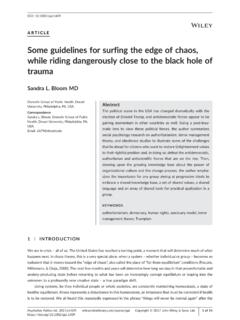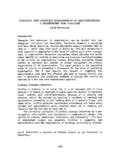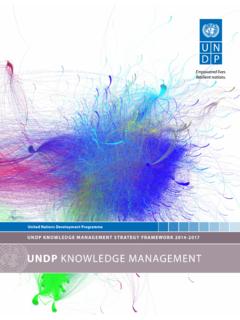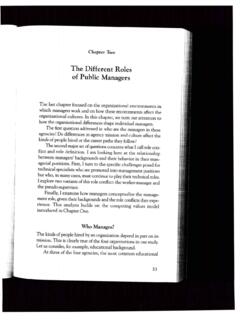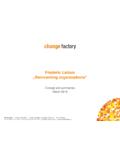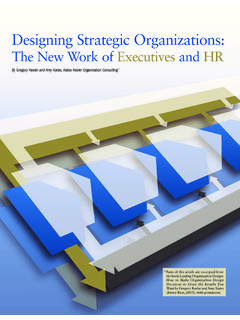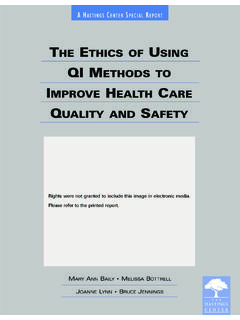Transcription of Neither liberty nor safety: the impact of fear on ...
1 Neither liberty NOR safety: THE impact OF FEAR ON individuals , institutions , and societies , part IISANDRA L. BLOOM, CommunityWorksABSTRACT This is the second in a series of four papers that look at the ways that mindsand bodies of individuals are affected by severe stress and use that as a way of developinga deeper understanding of what happens to stressed individuals who come together toform stressed organizations and the impact of this stress on organizational leaders. Theseries will also explore the parallel process that occurs when traumatized individuals andstressed organizations come together to form stressed societies . part I focused on thebasic human stress response.
2 In part II, we will begin exploring the more extended impactof severe, chronic, and repetitive exposure to stress on the functioning of the emotionalsystem, the ways in which human beings tend to adapt to adversity and thus come to normalize highly abnormal AFFECT ANDAGGRESSION: LOSS OF VOLUMECONTROL Infants are born with a number of raw affects , the word used to describe the bio-logical building blocks of emotional expe-rience. At birth we have only two settingsfor our internal emotional switch : on andoff. As a child develops, caregivers, andlater peers, model and teach the manage-ment of these raw affective states so thataffective arousal comes to match the degreeof importance of the stimuli.
3 As early as 11weeks, babies have already learned tomatch their mother s expressions ofsadness, anger, fear and happiness and have begun to join these expressions withbehaviours that suggest that matching ismeaningful. They are also beginning thelifelong process that involves using infor-mation about emotion to make decisionsfor their own behaviour, including lookingto other people to know whether theyshould engage in certain behaviours(Salovey and Sluyter, 1996).As a result of this complex process, bythe time we reach adulthood losing a penshould not arouse the same intensity of lossas losing a beloved pet; a neighbour s doggoing through your trash (probably) doesnot arouse the same degree of anger as theneighbour smacking your child; a terrorismalert in another country does not producethe same level of fear as it does when the same alert occurs nearby.
4 We call thisPsychotherapy and Politics International, 2(3) 212 228, 2004 Whurr Publishers 10/8/04 11:26 AM Page 212emotional modulation our volume control ,using the analogy of a knob on a radio oramplifier. Although there is enormous cul-tural variation in the methods each cultureuses to manage specific affect states, allcultures teach their children to do management is critical to learn-ing and the capacity to exercise reasonedjudgement. Emotions prioritize thinking bydirecting attention to important informa-tion. Emotions are sufficiently vivid andavailable to be used as aids for judgementand memory. Emotional mood swingschange one s perspective, encouraging mul-tiple points of view, and emotional statesdifferentially encourage specific problemapproaches (Mayer and Salovey, 1997).
5 Children who are exposed to repeatedexperiences of overwhelming arousal donot have the kind of safety and protectionthat they need for normal brain develop-ment and therefore they may never developnormal modulation of arousal, and thisseverely compromises their capacity foremotional management. As a result theyare frequently chronically irritable, angry,unable to manage aggression, impulsive,and anxious. This compromised emotionalmanagement interferes with learning andthe development of mature thoughtprocesses. Emotional dysregulation is adangerous handicap for the individual andfor the group because it is so likely to leadto violence directed at the self or and the adults they become who experience compromised emotionalmanagement will experience high levels ofanxiety when alone and in interpersonalinteractions.
6 They will understandablytherefore do anything they can to establishsome level of self-soothing and self-control. Under such circumstances, peoplefrequently turn to substances, like drugs oralcohol, or behaviours like sex or eating orrisk-taking behaviour, or even engagementin violence, including self-mutilation, all ofwhich help them to calm down, at leasttemporarily, largely because of the internalchemical effects of the substance or behav-iour. Human beings, human touch, couldalso serve as a self-smoothing device, butfor trauma survivors, trusting humanbeings may be too difficult. As children or as adults, the experienceof overwhelming terror destabilizes ourinternal system of arousal the internal volume control knob that we normallyuse to regulate our emotions.
7 People whohave been traumatized lose this capacity to modulate arousal and manage affect .Instead of being able to adjust their volume control , the person is reduced toonly an on-or-off switch, losing allcontrol over the amount of arousal theyexperience to any stimulus, even one asunthreatening as a lost pen or a neighbour sdog. They tend to stay irritable, jumpy, andon-edge. It takes only a relatively minimalfearful stimulus for them to experienceterror and their own typical defensive reac-tions to fear. To complicate the situation further emotions can kill. It is possible to die offright or to die of a broken heart. Mostfrightened people do not die, however,because of the built-in safety valve thatwe call dissociation.
8 Dissociation isdefined as a disruption in the usually inte-grated functions of consciousness,memory, identity, or perception of the environment (American PsychiatricAssociation, 1994). Dissociation buffersthe central nervous system against life-threatening shock. Through the dissocia-tion of affect we are able to cut off all ouremotions and in extreme cases of repetitiveand almost unendurable trauma this isknown as emotional numbing . We canNeither liberty nor 10/8/04 11:26 AM Page 213214also dissociate from the overwhelmingevent itself so that there are no words avail-able to even recall the event (amnesia). Thefailure to remember the events or toconnect the emotions associated with theevents with the memories of the events candoom the person to re-enact the traumaticevents later in life (Van der Kolk, 1989;Terr, 1990).
9 Emotions are built-in, part ofour evolutionary, biological heritage andwe cannot eliminate them we can onlysuppress them and this may not generallybe a good thing to do. There is an abun-dance of evidence from various sourcesthat unexpressed emotions may be verydamaging to one s mental, social, cognitiveand physical health (Pennebaker, 1997).The failure to develop healthy ways ofmanaging emotional arousal also interfereswith relationships. Mature emotional man-agement endows us with the abilities tointerpret the meanings that emotionsconvey regarding relationships, to under-stand complex feelings, and to recognizelikely transitions among emotions. Thegradual acquisition of this emotional intel-ligence allows us to monitor emotions inrelation to ourselves and others whilegiving us the ability to manage emotion inourselves and others by moderating nega-tive emotions and enhancing pleasant oneswithout repressing or exaggerating theinformation they convey (Mayer andSalovey, 1997).
10 Compromised emotional managementskills are also one mechanism of intergen-erational transmission since these skillsbuild up over time in the interactionbetween parent and child. Parents who havecompromised skills will be unable toprovide the important emotional learningexperiences that their children , the children will adapt to theparental style of managing emotions. LOSS OF VOLUME CONTROL INAN ORGANIZATIONAL CONTEXTHow does an organization manage emo-tional states? It does so through the normalproblem-solving, decision-making, andconflict-resolution methods that must existfor any organization to operate most organizations within oursociety function in a fundamentally hierar-chical, top-down manner, in a calm,healthy, well-functioning system there is acertain amount of natural democraticprocess that occurs in the day-to-day opera-tions of solving group problems, makingdecisions in teams, and resolving conflictamong members of the organization.



